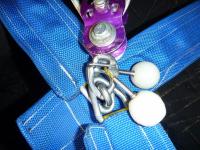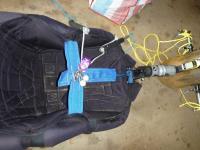-
Posts
63 -
Joined
-
Last visited
-
Days Won
1
Content Type
Profiles
Forums
Gallery
Downloads
KL Shop
Blogs
Articles
Everything posted by Chook
-
Same deal here with a friend flying mine. They are non critical so cut a new one out of a plastic bottle cap. Mount it so the dome of the cap faces the right way to be kinder on the sail. It got me out of trouble till the new parts turned up. I think the genuine Revolution shock cord and washers come as a kit and cost me a fortune (for what they were) when I bought them last.
-
This is a picture of my prototype that I built back in 2003 out of 1/4"- 6.3mm galvanized rod. I now use stainless steel. It's not clear in the photo but the whole frame is slightly tapered (the support crossing the axle with the inward bends is a total of 5/16" -8mm narrower than the other side support also welded onto the axle) When I start to roll a tail, it is sometimes easier to hook the swivel onto a solid object so the whole tail can rotate and undo the twists in the tail as I wind it up from the other end. (Mine are always rolled up on these winders so they roll back into their "edge crease marks" very nicely) I loop the first roll of the tail back over its self a few inches and make the first few rolls fairly loose to make it easier to remove from the winder when the roll is completed. By favoring the side with the high guides when rolling, I can spin it with my thumbs while holding the axle in both hands and roll it at a nice walking pace even when it's windy. It then slips off the winder, I fold it in halves and into it's bag.
-
So what foam do you use for the grips?
-

When you wish that little bit too hard for some wind...
Chook commented on jasonmcmahon76's blog entry in Trip the Kite Fantastic
Yeh. I fly into Rockhampton Queensland early on Thursday morning and will be at Yeppoon kite buggying for a month. I just checked and the current wind speed in front of cyclone Debbie and is 151 knots- 280kmh. -
Ahh OK. Sorry bout that. Now I see the reason and it now makes sense. Thanks for that. I live by the beach and this is pretty standard dress even in our shopping areas here. I queued behind a young lady dressed in only a bikini in the bank last Monday.
-
Am I missing something here. Dunno what you mean??
-
-
Get the kite control right first. Got to be able to hold a fixed bridle kite exactly where you want it on its brakes before you harness in or hot wire to a buggy. If the kite outflies your ability harnessed in, you will get spanked. A depower kite using a bar will require a harness and can do as much damage to your body if inexperienced. Start small and gain confidence and work up slowly in kite sizes/winds. It's the gusts that do the most damage. I taught my self and still do many hundreds of hours a year kite buggying, but still have the odd OBE.(out of buggy experience) If a kite hot launches (strait to the top of the wind window) you will certainly follow it, so if you can get someone to guide you it will be a lot more fun and safer. Me with helmet cam and full armour, purple kite and poking my tongue at the end with an OBE.
-
I'm in guys. I met you in Perth John (and you helped me out big time!!!!). I'm sure you would like it once again.
-
I totally agree. I was taught when learning to fly an aircraft, an easy way to understand the power of the wind in laymen's terms, is to just multiply the wind speed. If the wind is 6 knots...... 6 x 6 =36, then if its rising to 8 knots x 8 = 64, which is "almost" double the strength.
-
You can see here the extra row "D" of bridals to support the rear of the foil on a quality kite. Joel is restraining the kite after a learner got into a death spiral at launch after a handle slipped out of his hand. The brake lines work by adjusting the wings very trailing edge, just like ailerons on an aircraft. The 4 rows support the wings shape. At speed we reflex (let the brakes off to actually move the trailing edge slightly higher than the natural position of the airfoil) the trailing edge for even more speed. In the shot you can see how far back the kite is supported. The brakes are pulled on here to slow the kite for the photo. This is me with my 13.4 square meter Peter Lynn Vapor. And my 6.5 m2 on a beach in Queensland Australia. Hope this gives you some idea of the location of the support bridals.
-
These style of kites have no internal diagonal (fabric) bracing. So bunch up when not moving forward with enough speed to inflate them firmly. They usually don't have air transfer holes between the ribs. Also the B and C bridle lines (2nd and 3rd line from front) are situated too far forward and offer no support beyond the half way cord mark of the wing. It's a shame as with the same amount of effort during manufacture this bridal placement could be corrected very easily. Not sure what the easy answer is?? I too bought a cheapie when I first started power kiting and I'm sorry to say I cut it up and made it into windsocks.
-
Twice while flying a light aircraft I've had St Elmos fire coming off the tips of the propeller blades. A few years ago I was land sailing at Lake Lefroy in Western Australia with a mate. As a thunderstorm approached we headed back to camp in our yachts and had a metre long tube of crackling light coming off the tips of our carbon masts. After parking them on their side the mast were still crackling 20 minutes later after the rain had eased.
-
To set up my buggy for kiting. When running the strop line around a pulley block to a quick release and on my harness it's 17" between handles. When I'm "hotwired" (attachments are fixed to the buggy rails) it is 20". It's a personal thing to be comfortable. I have crook shoulders with broken tendons both sides so keep the handles in close so I don't have to reach out too far. Photo at Lake Lefroy Western Australia. 550 square kilometers of glass smooth salt. Picture was taken after a bit of light drizzle. There is no rolling resistance and I managed 90.7 kmh in 12 knots of breeze.
- 1 reply
-
- 2
-

-
Just fly your Hornet very much like a Rev kite. Hold it on the brakes so it doesn't "hot launch" straight to the top of the window. You tend to "superman" being pulled off your feet otherwise. If I launch in the centre of the window, holding it back with brakes only fly it up to about a wingspan and then turn it onto it's side and fly across the wind. If your using a buggy face the buggy at 45 degrees towards the kite and if it over powers you the buggy just rolls towards the kite. (I launch from a seated position in the buggy as I have a damaged leg. Nah not from buggying, it was from an encounter with a tiger snake. As it struck at me I tried to jump away and rolled my ankle and compressed my leg into my boot breaking my leg/foot in 15 places. It had already bitten me by then.)
-
Yeh I have a few Peter Lynn kites. 3x Reactors, 2x F-arks, 2x Vipers and 9x Vapors in different sizes I use for buggying. These shot were taken while on holidays in Queenland, Australia. I go there every Easter.
-
No luck yet..................anyone help?
-
For the amount of time expended building one it's much less head scratching to buy second hand. They come up quite regularly here and we have nowhere near your population density. Keep a lookout on Ebay or kite forums. Peter Lynn buggies always seem to be floating around and they transport really easily due to the way they pull to bits with only a few bolts.
-
Yeh I have built/modified 5 buggies and I own 2 x Sysmic S2. I leave one Sysmic S2 in Queensland on the East coast of Australia (The freight cost would be enormous) and fly over for a month each Easter to go kiting with mates in Yeppoon. I post my kites and motor bike armour ahead so it's there in time. I have since changed my Hot wire system to just 2 stainless steel loops on webbing attached to the side rails as the system pictured above didn't prove safe enough. (wouldn't release completely every time). Here 2 sets are pictured. It's fantastic fun and I cover a lot of kilometre every year either Land sailing or kite buggying. We always have a ball. Don't worry bout the old fart bit all the guys I was with in January this year in South Australia I reckon the average age would have been around 45 to 50. I'm 56. https://vimeo.com/94400055 Yeh it's me at the end before I started hot wiring.
-
Loved it !!!! Out the back of the ute (truck) looked cool down the laneway.
-
I thought about buying a travel frame and is there a reason it's 3 wrap. (just to be more robust????) I'd like a 2 wrap travel frame "if there is such a thing" as I like the lighter winds of an evening. I do notice a big difference going from a 2 wrap frame to the 3 in my 1.5B. I think the total remove for travel sound like cheap insurance for the sail. With a slight curve kept in the leading edge they come out very easily in one piece. (thanks JB for the video)
-
Still on the lookout for one please.
-
The safety release up close. I made the tapered release cones from stainless steel bolts and the white balls are made from melted HDPE plastic milk bottles and then turned up in the lathe. When activated/pulled the taper physically forces the whichard release catch open.
-
I used that type of pulley block on the "hot wire" system on my kite buggy. It wasn't up to the task as it would bind up with use. Even when I repacked the sintered bronze bearing with grease it would bind in a very short time. There was a lot of pressure on it. I ended up making a pulley block using 2 x 5608RS bearings for a smooth action that has lasted well. It's really important that a safety release "Whichard" (not of the pin type) is used when flying on handles, for those emergencies if it all turns ugly.

.thumb.jpg.07bf536149fcde18d2eabc4dd4578535.jpg)

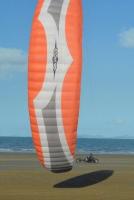
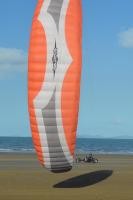
.thumb.jpg.7171f28feefca3e0f51dbb154f2dbc43.jpg)
.thumb.jpg.76a57282e5775e83429775bc8c7f4512.jpg)
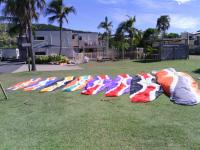
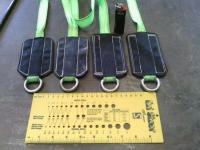
.thumb.jpg.da3f180dc6cfa80f51fa5f676870e37b.jpg)
